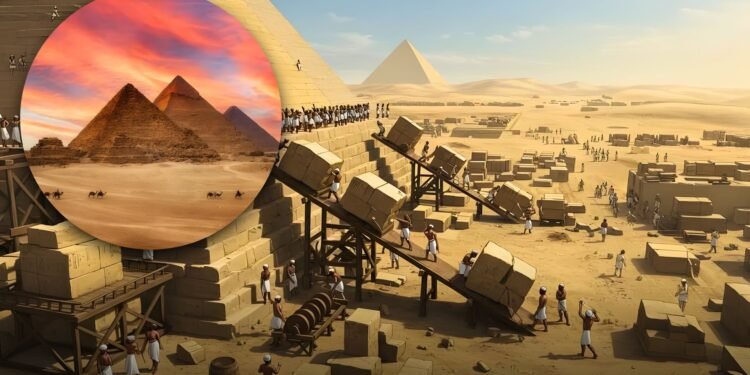The pyramids always come with baggage — not just limestone blocks, but centuries of bad history takes.
Hollywood showed Israelites whipped under the sun, and Bible stories doubled down on that image. But archaeology keeps dragging receipts out of the sand, and surprise: no chains, no whips, no slaves.
What built the Great Pyramids? Bread, beer, and one hell of a workforce.
Workers’ villages don’t scream slavery
At Giza, archaeologists uncovered a purpose-built village with dorms, meat bones, and endless bread jars. That’s not how you house disposable slaves — that’s how you keep a national workforce alive and grinding. Even inside Khufu’s pyramid, graffiti shows crew names like “Friends of Khufu,” proving these people took pride in their labor.
The numbers don’t lie
Forget Herodotus’ tall tales of 100,000 men breaking their backs. Modern estimates put it at 20,000 to 30,000 workers, supported by bakers, brewers, butchers, and craftsmen. Some were permanent, many rotated in during flood season when farming was pointless. The system looked less like slavery and more like the first version of a national service program — minus the HR memos.
Dig sites show a full-blown city
Archaeologist Mark Lehner uncovered entire workers’ cities with bakeries, copper workshops, and streets engineered like modern grids. Animal bones prove workers ate prime beef — not survival scraps. Over at Heit el-Ghurab, ruins of barracks show 1,600 workers bunked together, feasting on cattle, goats, and fish. That’s not slave chow; that’s ancient Egypt’s buffet line.
Not slavery, but obligation
Construction was powered by obligatory labor, the social tax of the Old Kingdom. Egyptians called it bak — everyone owed service, from farmers to elites. Think of it as forced community service, except your project was a 481-foot limestone triangle. And thanks to tight organization, workers were split into phyles, gangs, and crews, all tracked by supervisors. Efficiency, ancient-style.
Myths survive, facts don’t care
So why does the slavery myth stick? Blame Herodotus, Biblical narratives, and Hollywood epics like The Ten Commandments. Even Ridley Scott’s Exodus pushed the slave angle so hard Egypt banned the film. But digs keep torching that narrative. Evidence shows skilled Egyptians engineered ramps, sleds, and even water tricks to drag two-ton blocks across the desert. These weren’t aliens, lizards, or chained-up masses — they were citizens building a nation’s flex.
The pyramids aren’t monuments to slavery. They’re receipts of Egypt’s first mega-project: a blend of skilled labor, national duty, and social organization so advanced it still makes scholars sweat. Strip away the Hollywood myths, and what you see is a workforce fed, housed, and remembered. Turns out, the real chains were bureaucratic.












